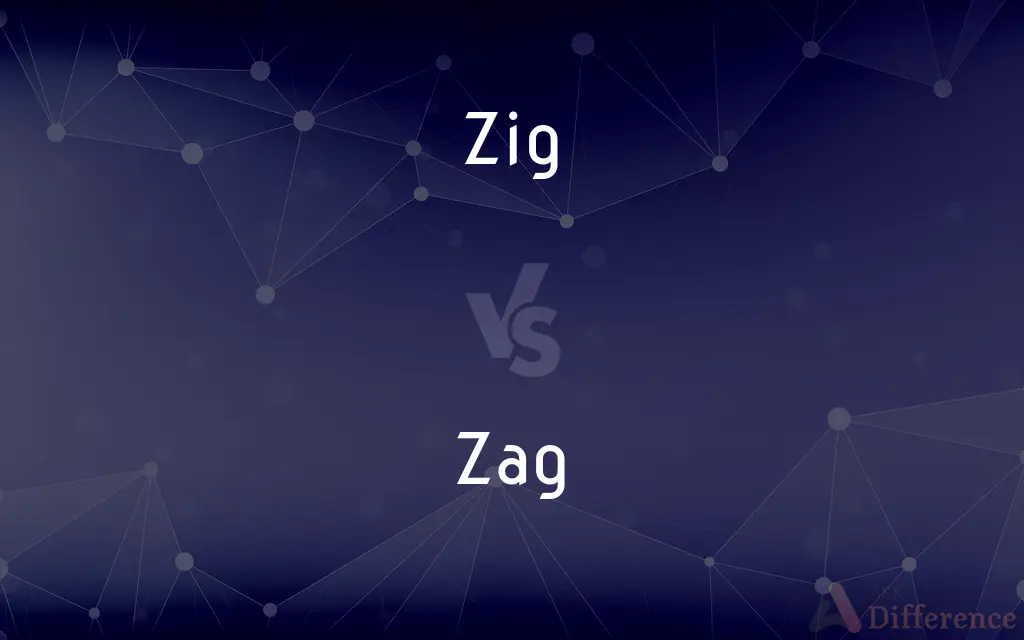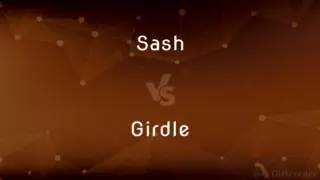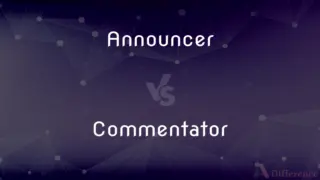Zig vs. Zag — What's the Difference?
By Tayyaba Rehman & Maham Liaqat — Updated on April 3, 2024
Zig refers to a sharp change in direction to one side, while zag indicates a sharp turn to the opposite side, often following a zig in a zigzag pattern.

Difference Between Zig and Zag
Table of Contents
ADVERTISEMENT
Key Differences
Zig represents a sudden sharp turn or angle in one direction, typically as part of a series of such movements. It suggests a deviation from a straight path, often to avoid an obstacle or to follow a more complex route. For example, a skier might zig to navigate around a tree on a slope. Conversely, zag is essentially the countermove to a zig, indicating a sharp turn in the opposite direction. This complementary action creates a zigzag pattern, which can be observed in various contexts, from the movement of athletes evading opponents to the design patterns in textiles.
In the context of patterns or designs, a zig might be represented as a diagonal line moving in one direction, creating an angle or peak. Such patterns are common in textiles, graphics, and even in the structuring of pathways or gardens. Whereas a zag would follow as the immediate diagonal line or angle moving in the opposite direction, together forming a continuous series of peaks and valleys, which is visually dynamic and often used to convey movement or to add interest to designs.
Zig and zag are also metaphorically used in describing erratic or unpredictable behavior, strategies, or movements in various fields. When someone zigs, they might be making an unexpected decision or taking an unconventional approach. In contrast, a zag would represent a subsequent unexpected decision or approach but in a different direction, suggesting adaptability and strategic unpredictability. This metaphorical use underscores the agility and dynamic nature of decision-making processes in competitive or changing environments.
In navigation, whether physical or digital, the terms zig and zag are employed to describe routes that are not straight but instead involve a series of sharp turns. A navigator might zig to avoid an obstacle or to follow a more advantageous route, and then zag to continue on their path. This can apply to literal navigation, such as sailing or hiking, or to more abstract forms of navigation, like navigating market trends in business.
Socially and culturally, zigging and zagging can refer to the way trends, opinions, or interests shift back and forth over time. A social trend might zig, gaining popularity or attention in one direction, and then zag as the collective interest swings in an opposite direction. This concept reflects the fluid and often cyclical nature of social and cultural dynamics, where shifts in one direction often prompt a corresponding shift in the opposite direction as reactions or adaptations.
ADVERTISEMENT
Comparison Chart
Definition
A sharp change in direction to one side.
A sharp change in direction to the opposite side.
Sequence
Typically precedes a zag in a zigzag pattern.
Follows a zig in a zigzag pattern.
Visual Representation
Represented as a diagonal line or angle moving in one direction.
Represented as a diagonal line or angle moving in the opposite direction.
Metaphorical Use
Implies an unexpected or unconventional decision/movement.
Implies a subsequent unexpected decision/movement in a different direction.
Navigation
Employed to describe a sharp turn or deviation from a straight path.
Used to describe a sharp turn back towards the intended path or direction.
Social/Cultural Dynamics
Can refer to a shift in trends, opinions, or interests in one direction.
Refers to the counter shift in trends, opinions, or interests.
Compare with Definitions
Zig
A strategic or unexpected move.
In negotiations, sometimes you have to zig when they expect you to stay straight.
Zag
A sharp turn or angle in the direction opposite to a preceding zig.
After the zig, the skier executed a perfect zag around the next obstacle.
Zig
Part of a pattern characterized by sharp turns.
The fabric's design incorporates zigs that ascend diagonally.
Zag
Reflecting a shift back after a social or cultural trend.
After the trend zigs towards minimalism, it often zags back to extravagance.
Zig
A deviation from a direct course.
The hiking trail zigs sharply to avoid the rocky outcrop.
Zag
The complementary angle or line in a zigzag pattern.
Each zag in the wallpaper's pattern balances the preceding zig.
Zig
Metaphorically, a sudden change in opinion or strategy.
The politician's stance zigged following public outcry.
Zag
A countermove or strategic shift in an unexpected direction.
The company zagged with its new product launch, surprising competitors.
Zig
A sharp turn or angle in one direction.
The rabbit zigs to evade the pursuing fox.
Zag
A correction or alteration of course back towards a target.
After zigging away from the main path, the runner zagged back towards the finish line.
Zig
One of a series of sharp turns or reversals
The zigs and zags of foreign policy.
Zag
One of a series of sharp turns or reversals
Many zigs and zags in the mountain road.
The zigs and zags of the stock market.
Zig
To turn or change direction suddenly. Usually used in contrast to zag
When your opponent zigs, zag!.
Zag
To turn or change direction suddenly. Usually used in contrast to zig
The runner zigged when he should have zagged.
Zig
To behave erratically or indecisively. Usually used with zag
The market has zigged and zagged for months.
Zag
To behave erratically or indecisively. Usually used with zig
Zigging and zagging for years over the question of disarmament.
Zig
A sudden or sharp turn or change of direction.
Zag
One of a series of sharp turns or reversals.
Zig
To make such a turn.
Zag
Twist in a storyline
Zig
An angular shape characterized by sharp turns in alternating directions
Zag
(intransitive) To move with a sharp turn or reversal.
Zag
An angular shape characterized by sharp turns in alternating directions
Common Curiosities
Are zig and zag always used together?
While commonly used together to describe a zigzag pattern, "zig" and "zag" can be used independently to describe single sharp turns.
Is there a limit to how many times something can zig and zag?
There's no inherent limit; the terms can describe any number of alternations between directions.
Do zigs and zags always occur in equal measure?
In a literal or visual zigzag pattern, yes, but metaphorically or in other contexts, the balance can vary.
How do zigs and zags affect the speed of movement?
Zigzagging can slow down direct progress towards a destination but may be strategically used for evasion, exploration, or other purposes.
Is zigzagging more efficient than a straight path?
It depends on the context. Zigzagging can be more effective for avoiding obstacles or enemies, but it's generally less efficient in terms of distance covered.
How do zig and zag relate to adaptability?
The concepts embody the idea of flexibility and adaptability, highlighting the importance of being able to change direction or strategy swiftly in response to changing conditions.
Can zig and zag be applied to non-physical movements?
Yes, they're often used metaphorically to describe shifts in strategies, decisions, or trends.
Can zigging and zagging be planned?
Yes, zigzag movements can be part of a deliberate strategy or design, both in physical navigation and in metaphorical uses.
Can the concept of zig and zag be applied to personal decision-making?
Absolutely, individuals might zig or zag in their personal choices, careers, or life paths in response to opportunities or challenges.
Are there industries where zigging and zagging are particularly important?
Yes, in sectors like finance, sports, and marketing, the ability to effectively zig and zag can be crucial to navigating challenges and seizing opportunities.
Share Your Discovery

Previous Comparison
Sash vs. Girdle
Next Comparison
Announcer vs. CommentatorAuthor Spotlight
Written by
Tayyaba RehmanTayyaba Rehman is a distinguished writer, currently serving as a primary contributor to askdifference.com. As a researcher in semantics and etymology, Tayyaba's passion for the complexity of languages and their distinctions has found a perfect home on the platform. Tayyaba delves into the intricacies of language, distinguishing between commonly confused words and phrases, thereby providing clarity for readers worldwide.
Co-written by
Maham Liaqat















































